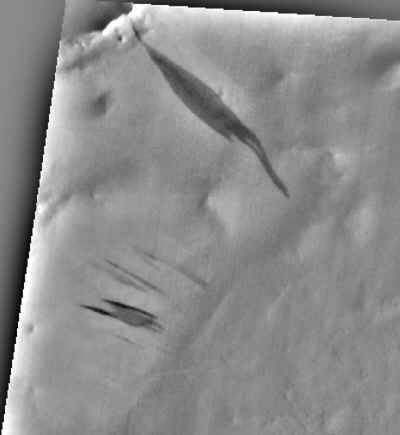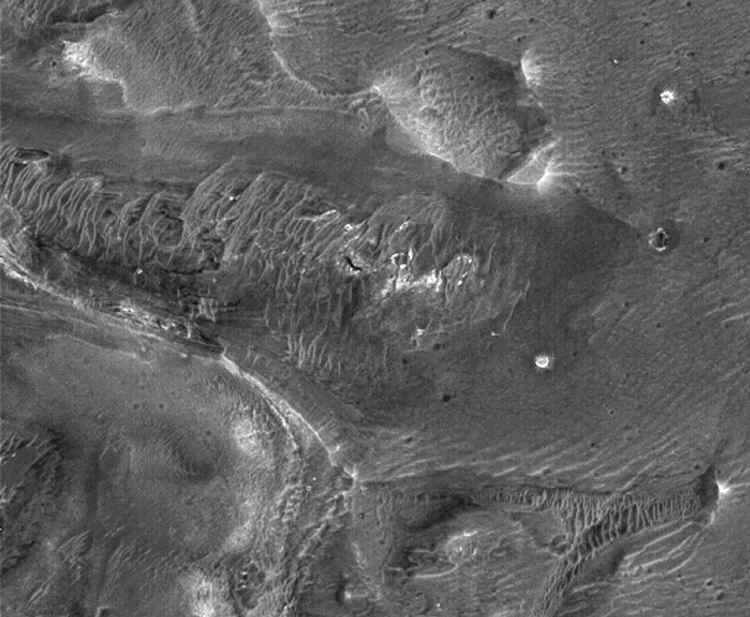Water on Mars Confirmed by Hoagland--
Mars Reveals More Bizarre Secrets --
Is This Evidence of "Organic Technology?"
As we have continued to examine images from the Mars Global Surveyor image dump, we have have been increasingly astounded. Not just by the sheer volume of data and overt weirdness of what we have found, but the overwhelming artificiality of some of these features. Yet still we are running across a number of images that just plain seem to defy our own model of what Mars really is, and what it may have become.
Inevitably, that was to be expected. As many astronomers are recently learning, the universe seems to have a penchant for reminding us of what we don't know as we seek to confirm what we think we do know about it. Frankly though, what we are presenting tonight is so far outside of our experience, so far beyond even our own daring models of the artificiality of Mars, that we are not sure we can even classify it as technology. Indeed, if it is technology, it is of a type and origin we cannot quite fathom.
We only know one thing. It ain't "geology" in any sense of the word or science.
We're going to start out with the fairly mundane new discoveries. During the recent "Water on Mars" press conference, Michael Malin and Ken Edgett of MSSS suggested that water should be preferentially found at mid latitudes rather than the far Northern and Southern latitudes (above 30°) where it appeared most frequently. Further, the water should be seeping from crater faces that were directly exposed to the sun, when instead it was found most commonly on the poleward slopes of the crater walls, where it should have been too cold to be in a liquid state. We suggested that the reason for this was that an artificial Martian piping system was bursting as the liquid water froze in them, and presented photographic evidence of this extensive piping system. Even though they admitted that their own model was inadequate to explain the phenomenon, they put forth an idea that the water was bursting forth from from semi-permeable liquid pockets in crater walls. Yet they provided no examples of any mid latitude "poleward" facing seepages.

Leave it to us, as usual.

Click on thumbnail for larger version
Enterprise principal investigator Richard C. Hoagland has found an image, SP2-33806, that shows a water seepage that exactly fits the Malin\Edgett model. As you can see from the image above, water is clearly seeping from a dark crack in the crater rim and running down the slope of the crater wall that faces the direct sunlight. Add to that the fact this crater sits at about 10° N., precisely the kind of mid latitude location for their model to work, and there can be little doubt what Hoagland has found. Note also that the darkest portion of the flow is in the middle, where the largest amount of water would be in such a scenario.
Now there is only one real problem with this. The water is so dark, so obviously fresh, that it begs the question of just how long ago this happened. Water should evaporate rapidly in the exposed Martian environment. So rapidly in fact, that unless the water flow causes a destructive action on the crater wall, i.e. a groove or channel, there should be no real evidence left that the water was ever there. In this case, there is no such "destructive force" visible in the flow. It's just a dark, wet patch. Which means is that it must have been a very gentle flow, and it must have happened only hours or even moments before MGS snapped this image. Not only have we confirmed that there is flowing liquid water on Mars, we've caught Mars in the act!
And the beauty of it is that it in no way changes the inadequacy of their model to explain the high latitude poleward facing water, which our piping model still elegantly explains.
Now, we suggest to all you intrepid Enterprise readers out there that you get on the pipe (pun intended) and tell Messer's Malin and Edgett that somebody has found confirmation of their water on Mars scenario. And all they have to do find out about it is call their pal Richard Hoagland. And drop a note to Dan Goldin, John McCain, CNN and ABC news while you're at it.
MALIN SPACE SCIENCE SYSTEMS, INC.
SAN DIEGO, CA 92191-0148
TELEPHONE: (858) 552-2650, EXT. 500
https://www.msss.com/
John McCain 202-228-2862 Email:
">
NASA (Dan Goldin) 202-358-2810
ABC (Ted Koppel) 202-222-7976
ABC (Ted Koppel) 202-222-7680
CNN 404-681-3578 White House 202-456-2461
Pat Buchanan 703-734-2705 Libertarian Party 202-333-0072
Capitol Hill 202-224-3132 (Ask for Senators Fax Number)
Now this image, from the center-east portion of the Aram Chaos crater-fill, is truly one of the most bizarre we have seen. The image is over 53 km long, and contains some remarkable features. The two most significant are a pair of similar teardrop shaped formations that both scale about 2.5 km across. They seem to be made up of the tubing we have seen at other locations. In this portion of the image we see the first object, which is made up of a series of sinewy tubes or ropes extruding from a layered wall or chasm in the surrounding terrain.

To the right of this portion of the image is what looks to be a tear or rift in the crater floor, inexplicably filled with more of the "yarn" or tubes that seem to be holding it together. These are clearly cylindrical features, not flowing flat dunes. Note that some of them start from the top side and others from the bottom, in a strange intertwining effect that would logically make the seam very strong.

Above that, in the "body" of the actual object itself, we can see the layered "wall," and evidence of geometric cells in the vertical face. The "ropes" seem to cluster in certain locations, which would make sense if they were part of a distribution system of some kind as opposed to natural features. Note also that as we have seen before, the tubes are brighter than the surrounding terrain, implying a different composition. At the bottom of the layered vertical face is an exposed, tiered set of objects that can only be described as "structures." Note the bright, regular, repeating vertical reinforcements. And even though they are on different "floors," they line up!

This kind of consistent, matching geometry is exactly what we would expect to see in an artificial, architectural structure. But even that somewhat remarkable observation failed to prepare us for what we found next ...
